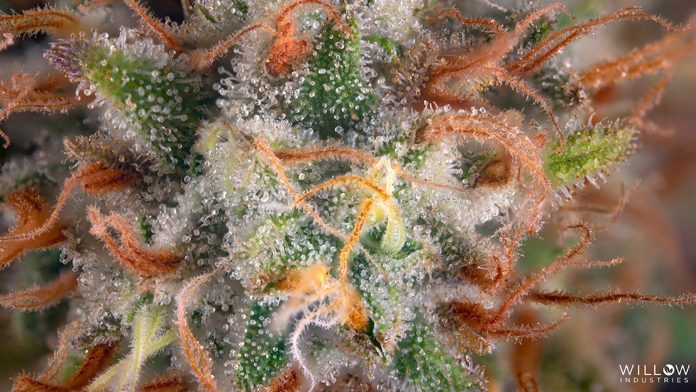Industry-leading plant extraction and post-processing specialists PURE5™ take us on an insightful journey into the world of cannabis terpenes, their vast array of health benefits and how PURE5™’s cutting-edge technology ensures the highest quality terpenes on the market.
Terpenes are chemical compounds naturally present in plants and contribute to their unique taste, smell, and colour, with scientists already identifying more than 20,000 different terpenes. They are the main elements in essential oils and are often used in food supplements, perfumery, and aromatherapy, and their healing properties are increasingly discussed in regards to various health problems.
Table of Contents
ToggleFor example, Cannabis Sativa species, such as hemp, contain a considerable number of terpenes, which, in addition to providing flavour, have numerous therapeutic properties. Some act antibacterial, whereas others have a relaxing effect against muscle cramps. In the colours of the cannabis plant, they enhance the action of cannabinoids, thus their healing qualities, which have a great future in medicine.
What are terpenes?
Terpenes are oils extracted from the leaf or the flower of the cannabis plant, which produces full-body cannabinoids such as CBG, CBC, CBD, and THC during flowering. Cannabis produces about 100 of those identified by scientists to date. The interest in cannabis terpenes does not stop only with their aromatic qualities; numerous studies have shown that they interact with cannabinoid receptors from our endocannabinoid system, either suppressing or enhancing the action of cannabinoids. As a result, there are numerous health benefits.
What is the role of terpenes in plants?
Terpenes are produced in the trichomes of the hemp plant. Trichomes are shiny, sticky sponge-shaped crystals located on the surface of the leaves and act as a protective mechanism in nature, taking care of the protection of the plant. Thus, on the one hand, they have the task of preventing the development of various colonies of bacteria and fungi on the plant and repelling various dangerous insects; however, on the other hand, they attract insects that help pollinate. For this reason, these compounds are found in the highest concentrations in the flowers of female unpollinated hemp plants.
The amount and composition of aromatic compounds depend on genetics and the state of the environment. Although the exact composition of the compound is specific to each plant, each variety has similar characteristics due to the combination of aromatic substances in related plants being very close genetically.
As an example, it can be added that the use of terpenes in hemp cultivation can double the antidepressant effect of CBD or increase the amount of THC with anti-inflammatory or sedative effects in a variety. As you can see, there are many different medical applications and research in this direction is yet to intensify. Also, the pharmaceutical industry is studying the effect of terpenes individually or through their interaction.
Different types of terpenes
MYRCENE
Myrcene is the most common terpene in sativa cannabis. In some varieties, more than 60% of the essential oil consists of mycelium. It smells like cloves, with scientists believing that myrcene is a powerful analgesic, anti-inflammatory, and antibiotic.
Myrcene blocks the action of cytochrome, aflatoxin B and other carcinogens. It has a relaxing, calming, antispasmodic and sedative effect. Myrcene works synergistically with THC and may also increase psychoactive potential.
Citrus essential oil contains high levels of myrcene. Therefore, many people claim that eating mango 45 minutes before consuming psychoactive cannabis enhances its effect.
LIMONENE
Limonene is the second terpene found in hemp resin and is responsible for the smell of citrus fruits. Similarly to myrcene, limonene has antifungal, antibacterial, and anticancer properties and is also believed to protect against carcinogens in smoke.
A 2013 cancer study found that terpene reduced tumours in women with early-stage breast cancer. Limonene quickly and easily penetrates the blood barrier, which increases systolic blood pressure. Some experts say that lemon increases attention, focus, creates a sense of comfort and increases sexual desire. Citrus, rosemary, juniper, mint, and some pine needles are some of the plants that contain limonene.
CARYOPHYLLENE
Many herbs and spices contain caryophyllene. For example, black pepper contains large amounts of caryophyllene, which give it its characteristic spicy taste. Like the previous two terpenes, caryophyllene has anti-inflammatory, analgesic, and antifungal properties; it has an affinity for the CB2 receptors of our body, which makes it an essential ingredient in anti-inflammatory creams.
Topical application of caryophyllene also relieves toothache. This terpene has a promising role in the treatment of alcoholism. In a study on mice, the researchers found that caryophyllene reduced voluntary alcohol intake. Black pepper, Thai basil, cloves, and cinnamon leaves contain caryophyllene, with lavender also producing caryophyllene in small amounts.
PINENE
Pinene, as the name suggests, creates the scent we associate with pine and fir trees. Doctors utilise pinene in medicines as an expectorant, anti-inflammatory, and topical antiseptic. Like lemon, it is believed to improve concentration, evoke a sense of satisfaction, and increase energy in the body. Patients who have arthritis, Crohn’s disease, and cancer may benefit from pineapple. Many coniferous and non-coniferous plants, as well as some citrus, produce pinene.
TERPINEOL
Terpineol smells of blooming lilacs, as well as apple and linden flowers. Plants with high levels of pinene often produce terpineol, which can cause a sedative effect. During tests on mice, terpineol was found to reduce mobility by 45%. High levels of terpineol are also found in some varieties of hemp, especially in indica. Experts believe that terpineol has antibiotic and antioxidant properties, and terpineol growers often extract this terpene from cypress trees.
BORNEOL
Borneol smells of mint and camphor. Chinese herbalists use borneol in medicines for fatigue, stress, and long-term illness. Some researchers believe that the natural properties of terpenes to repel insects can be used against diseases caused by ticks, fleas, and mosquitoes, such as West Nile fever and malaria, with one published study demonstrating that borneol kills breast cancer cells.
LINALOOL
Linalool has a colourful scent like lavender and spring flowers; It is currently used to treat various types of cancer. Linalool has a calming effect, reduces anxiety, and causes sedative effects. Linalool is responsible for the sedative effects of some cannabis varieties. In tests on mice, their activity decreased by 75%. It also has analgesic and antiepileptic properties. Patients suffering from arthritis, depression, seizures, insomnia, and cancer may benefit from this terpene. Some of the plants that contain linalool are mint, bay leaf, cinnamon, rosewood, and birch. Linalool is a precursor in the formation of vitamin E.
CINEOLE (EUCALYPTOL)
Eucalyptol is the main ingredient in eucalyptus essential oil. It has a strong mineral smell and is found in small amounts in cannabis. Eucalyptol relieves pain, improves concentration, and helps to achieve mental balance. It has potential benefits in the treatment of Alzheimer’s disease, but research is still at an early stage. Eucalyptus, bay leaves, sage, basil, and cardamom contain significant amounts of eucalyptol.
NEROLIDOL
Nerolidol has a unique, woody, and fresh bark aroma. Nerolidol shows antifungal, anticancer, and antimalarial properties and protects us from some types of parasites. Ginger, jasmine, lavender, and tea tree oil contain high amounts of nerolidol.
How Our Technology Does it?
From what we know, the potential benefits from terpenes are promising. These organic, naturally occurring compounds not only enhance and inform your cannabis experience but also offer great medicinal benefits to patients. Terpenes have been used for thousands of years by cultures worldwide for their healing properties, and as cannabis science expands, the possibilities to help more people become increasingly exciting.
At PURE5™, we have attained a high-level dynamo in which terpene profiles can be leveraged to target specific end-user outcomes. Our extraction reactor, dubbed The Low Low, captures the flower’s natural essence in a highly concentrated form, underscoring the PBX-STANDARD. Our hemp terpenes are produced using a non-destructive pure botanical extraction process in which all terpenes are captured in an unaltered profile, suspended in natural plant oils.

We are announcing our 20L MAX R134a extraction system that can extract the plant resin at room temperature at extremely high potency and yield while preserving all-natural derived terpenes and flavours. PURE5™ is an industry leader for introducing the PURE cannabis plant processing equipment that preserves all natural oils and phytoplasma in the content of the extract.
Beginning with the highest quality hemp flower and coupled with Pure Botanical Extraction (PBX-STANDARD), our products are made from the highest concentration of naturally occurring terpenes. Check out a sample of our terpene profiles below. Please note the full spectrum of terpenes present in our PBX Oils.
Dr George Stantchev, the CEO of PURE5™, said: “We can obtain all terpenes and resins present in the flowers we extract!”








